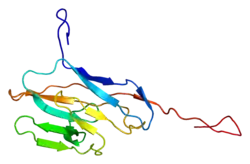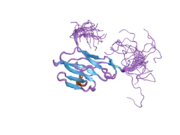CEACAM8
Carcinoembryonic antigen-related cell adhesion molecule 8 (CEACAM8) also known as CD66b (Cluster of Differentiation 66b), is a member of the carcinoembryonic antigen (CEA) gene family. Its main function is cell adhesion, cell migration, and pathogen binding.[3]
| CEACAM8 | |||||||||||||||||||||||||||||||||||||||||||||||||||
|---|---|---|---|---|---|---|---|---|---|---|---|---|---|---|---|---|---|---|---|---|---|---|---|---|---|---|---|---|---|---|---|---|---|---|---|---|---|---|---|---|---|---|---|---|---|---|---|---|---|---|---|
 | |||||||||||||||||||||||||||||||||||||||||||||||||||
| |||||||||||||||||||||||||||||||||||||||||||||||||||
| Identifiers | |||||||||||||||||||||||||||||||||||||||||||||||||||
| Aliases | CEACAM8, CD66b, CD67, CGM6, NCA-95, carcinoembryonic antigen related cell adhesion molecule 8, CEA cell adhesion molecule 8 | ||||||||||||||||||||||||||||||||||||||||||||||||||
| External IDs | OMIM: 615747 HomoloGene: 68205 GeneCards: CEACAM8 | ||||||||||||||||||||||||||||||||||||||||||||||||||
| |||||||||||||||||||||||||||||||||||||||||||||||||||
| |||||||||||||||||||||||||||||||||||||||||||||||||||
| |||||||||||||||||||||||||||||||||||||||||||||||||||
| |||||||||||||||||||||||||||||||||||||||||||||||||||
| Wikidata | |||||||||||||||||||||||||||||||||||||||||||||||||||
| |||||||||||||||||||||||||||||||||||||||||||||||||||
Use
CEACAM8 is expressed exclusively on granulocytes and used as granulocyte marker.
See also
References
- GRCh38: Ensembl release 89: ENSG00000124469 - Ensembl, May 2017
- "Human PubMed Reference:". National Center for Biotechnology Information, U.S. National Library of Medicine.
- "Entrez Gene: CEACAM8 carcinoembryonic antigen-related cell adhesion molecule 8".
Further reading
- Khan WN, Frängsmyr L, Teglund S, et al. (1992). "Identification of three new genes and estimation of the size of the carcinoembryonic antigen family". Genomics. 14 (2): 384–90. doi:10.1016/S0888-7543(05)80230-7. PMID 1427854.
- Oikawa S, Inuzuka C, Kuroki M, et al. (1991). "A specific heterotypic cell adhesion activity between members of carcinoembryonic antigen family, W272 and NCA, is mediated by N-domains". J. Biol. Chem. 266 (13): 7995–8001. doi:10.1016/S0021-9258(18)92930-3. PMID 2022629.
- Berling B, Kolbinger F, Grunert F, et al. (1990). "Cloning of a carcinoembryonic antigen gene family member expressed in leukocytes of chronic myeloid leukemia patients and bone marrow". Cancer Res. 50 (20): 6534–9. PMID 2208113.
- Arakawa F, Kuroki M, Misumi Y, et al. (1990). "Characterization of a cDNA clone encoding a new species of the nonspecific cross-reacting antigen (NCA), a member of the CEA gene family". Biochem. Biophys. Res. Commun. 166 (3): 1063–71. doi:10.1016/0006-291X(90)90975-S. PMID 2306228.
- Eades-Perner AM, Thompson J, van der Putten H, Zimmermann W (1998). "Mice transgenic for the human CGM6 gene express its product, the granulocyte marker CD66b, exclusively in granulocytes". Blood. 91 (2): 663–72. doi:10.1182/blood.V91.2.663. PMID 9427723.
- Torsteinsdóttir I, Arvidson NG, Hällgren R, Håkansson L (1999). "Enhanced expression of integrins and CD66b on peripheral blood neutrophils and eosinophils in patients with rheumatoid arthritis, and the effect of glucocorticoids". Scand. J. Immunol. 50 (4): 433–9. doi:10.1046/j.1365-3083.1999.00602.x. PMID 10520185. S2CID 5692060.
- Oikawa S, Sugiyama M, Kuroki M, et al. (2001). "Extracellular N-domain alone can mediate specific heterophilic adhesion between members of the carcinoembryonic antigen family, CEACAM6 and CEACAM8". Biochem. Biophys. Res. Commun. 278 (3): 564–8. doi:10.1006/bbrc.2000.3858. PMID 11095950.
- Singer BB, Scheffrahn I, Heymann R, et al. (2002). "Carcinoembryonic antigen-related cell adhesion molecule 1 expression and signaling in human, mouse, and rat leukocytes: evidence for replacement of the short cytoplasmic domain isoform by glycosylphosphatidylinositol-linked proteins in human leukocytes". J. Immunol. 168 (10): 5139–46. doi:10.4049/jimmunol.168.10.5139. PMID 11994468.
- Zhao L, Xu S, Peterson C, et al. (2002). "Purification and characterization of a 95-kDa protein--carcinoembryonic antigen-related cell adhesion molecule 8--from normal human granulocytes". J. Immunol. Methods. 270 (1): 27–35. doi:10.1016/s0022-1759(02)00215-6. PMID 12379336.
- Strausberg RL, Feingold EA, Grouse LH, et al. (2003). "Generation and initial analysis of more than 15,000 full-length human and mouse cDNA sequences". Proc. Natl. Acad. Sci. U.S.A. 99 (26): 16899–903. Bibcode:2002PNAS...9916899M. doi:10.1073/pnas.242603899. PMC 139241. PMID 12477932.
- Grimwood J, Gordon LA, Olsen A, et al. (2004). "The DNA sequence and biology of human chromosome 19". Nature. 428 (6982): 529–35. Bibcode:2004Natur.428..529G. doi:10.1038/nature02399. PMID 15057824.
- Gerhard DS, Wagner L, Feingold EA, et al. (2004). "The status, quality, and expansion of the NIH full-length cDNA project: the Mammalian Gene Collection (MGC)". Genome Res. 14 (10B): 2121–7. doi:10.1101/gr.2596504. PMC 528928. PMID 15489334.
- Ramachandran P, Boontheung P, Xie Y, et al. (2006). "Identification of N-linked glycoproteins in human saliva by glycoprotein capture and mass spectrometry". J. Proteome Res. 5 (6): 1493–503. doi:10.1021/pr050492k. PMID 16740002.
External links
- CEACAM8+protein,+human at the U.S. National Library of Medicine Medical Subject Headings (MeSH)
- Human CEACAM8 genome location and CEACAM8 gene details page in the UCSC Genome Browser.
- PDBe-KB provides an overview of all the structure information available in the PDB for Human Carcinoembryonic antigen-related cell adhesion molecule 8 (CEACAM8)
This article incorporates text from the United States National Library of Medicine, which is in the public domain.
This article is issued from Wikipedia. The text is licensed under Creative Commons - Attribution - Sharealike. Additional terms may apply for the media files.


